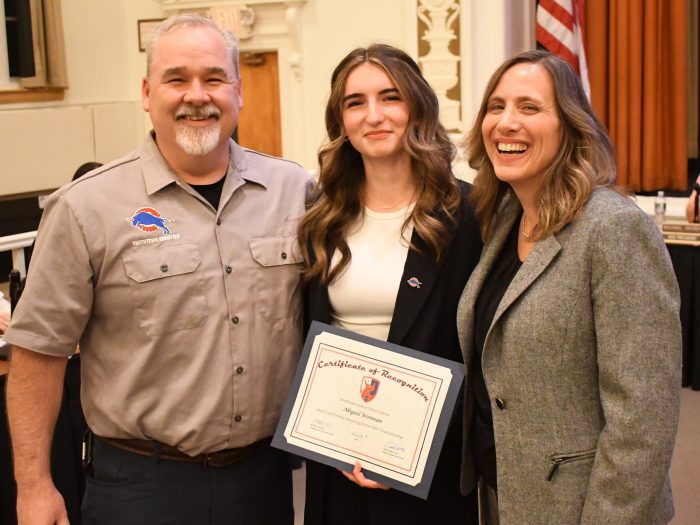Smithtown BOE meeting discusses armed guards, policy matters, time-out rooms

By Leah Chiappino
During the April 11 Smithtown Central School District Board of Education meeting, the district honored students who achieved high placements in the Robotics Competition and DECA state finals, where each competitor chooses to compete in one of four career clusters: marketing, business management and administration, hospitality and tourism, or finance.
The district also passed policies relating to time-out rooms, and updates to the Freedom of Information Act.
Armed guards
During the public participation portion of the meeting, Maddox Elbert, Smithtown High School East’s Class of ’26 president, spoke out against the district’s February decision to hire armed guards.
“I’m not a criminal,” he said. “My classmates are not criminals and my teachers are not criminals. Stop treating us like them.”
He went on to cite a variety of statistics and arguments against armed guards, including increased anxiety and cases in which armed guards were on campus during shootings.
Matthew Gribbin, BOE president, thanked Elbert for expressing his concerns, noting the decision was not made lightly and offering to discuss it with him further.
“When it’s our responsibility to protect over 8,000 students, we take that extremely seriously and we understand that not everybody will agree with it,” Gribbin said. “But we’re not going to sit back and wait and hope nothing happens.”
“I wouldn’t be able to live with myself if we had the opportunity to protect our students and our staff and our community, and we didn’t,” he added.
Policy meeting
Trustees Michael Catalanotto, and Michael Saidens along with an attorney for the district, Steven Goodstadt, Superintendent Mark Secaur, among others, met at a prior policy meeting.
Officials reviewed policy with Goodstadt, and discussed certain areas to be updated.
Saidens suggested the district could have parents sign a form noting they reviewed the school’s concussion policy rather than them hearing it in passing. Other policies for review included enforcement of nonresident students attending the district. Goodstadt recommended the district updates policy further, specifically proof of residency requirements, to make the policy more enforceable.
Officials agreed to bring in feedback from administrators and faculty before suggesting changes to the district’s social media policy between students and teachers
Secaur said he thinks the policy should set clear boundaries for students and teachers for what they can and can’t do. Saidens said social media should be used positively to highlight students, but acknowledged there was a possibility that contact between students and faculty could go down the wrong road. Saidens did not respond to a request for comment to further clarify his position.
The policy presently prohibits staff from posting “pictures, video or any other material that identifies students or provides any information that would be considered confidential” on social media sites “Twitter, Facebook, Instagram, Snapchat, VSCO, LinkedIn, Messenger, Pinterest, Yelp, Google, WordPress, YouTube, blogs, etc.” It also requires staff to keep their personal social media activities/accounts private from students.
Time-out rooms
The school board adopted a policy relating to a time-out rooms, which will be used in cases in which the “Committee on Special Education has made a recommendation that this type of behavior management approach would be appropriate.”
The rooms are meant to give students an opportunity to de-escalate and regulate their emotions, so they can return to instruction. The policy states the rooms are to be used “in conjunction with a therapeutic behavior management intervention” or in an emergency situation. The use of the rooms must be specified in the student’s individualized education program, which also needs to give direction on the maximum amount of time students can stay in the room, taking into account their age and needs.
Parents need to be notified prior to the rooms being used and must be shown the space upon request. The amount of time students are in the rooms will be carefully monitored to “ensure that a time-out room is not being used to the detriment of a student or student’s educational program.”
A room can never be locked, and a staff member must be able to see and hear the student.






